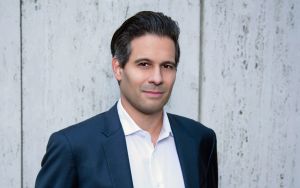Presented By: Safehold
Safehold Ground Leases Offer Model for Future of Real Estate Ownership
Future Of Ground Leasing, Presented by Safehold

Four years after modernizing the ground lease, Safehold is seeing increasing evidence of its capital solution unlocking hidden value for building owners across a portfolio approaching $4 billion.
Partner Insights spoke to Marcos Alvarado, Safehold’s president and chief investment officer, to learn more about how the company is pursuing its mission to transform a $7 trillion industry.

Commercial Observer: Safehold’s creation of the modern ground lease industry has given building owners a new tool to unlock hidden value. What key innovations made this evolution possible?
Marcos Alvarado: Ground leases have been around forever. But nobody ever said, “Let’s put the customer first.” That was our primary objective when we launched the business just over four years ago.
We were looking at how we could create incremental value, allow our customers to be more capital efficient, reduce their risks, and reduce the friction costs on their real estate transactions. We removed variables that made it difficult to underwrite ground leases and historically destroyed value. Reinventing ground leases as a customer-focused business was the real innovation.
We want our customers to think about using ground leases at multiple points in the life cycle of an asset, so we’ve evolved our offerings to accommodate each stage. We’ve launched SAFE x SWAP, where we acquire existing ground leases and modernize them. We’re preliminarily exploring a program to help customers who are looking at upgrading their buildings and reducing their carbon footprint, called SAFE Planet. We’ve even started to do ground leases on development transactions, targeting an even earlier part of the life cycle with a product called Ground Lease Plus.
How does a Safehold ground lease provide a competitive advantage for owners and operators?
The way we think about it is threefold: capital efficiency, friction costs and reduced risk.
If you’re an owner of an asset or a fund manager, you want to be the most efficient with your capital structure, and that is fundamentally what our ground lease accomplishes. When you own a piece of real estate, you actually own two things: the building and the land. The building is a high-effort, high-return business — marketing, developing, leasing, managing, and ultimately creating value for your investors. The land investment is a passive investment, and the same investor base shouldn’t own assets that have drastically different risk profiles. Utilizing our ground lease unlocks this value as our customers are more efficient with their capital.
Every time an asset sells or refinances, there are a tremendous amount of friction costs, such as title or recording taxes, hedging costs, lawyers — the list goes on, and they can add up to 3, 4, even 7 percent of the asset value depending on the market. If we buy 35 percent of that building’s value in the land, park it and never sell it, that friction cost is gone. There’s value created.
And the third component is reduced risk. Real estate is a cyclical business. If you’re invested in a quality institutional asset, you can survive a down cycle if you don’t have a liquidity squeeze. A large portion of that capital stack doesn’t come due with a ground lease. These three differentiators have resonated with our customer base.
How have Safehold’s interactions with the market changed over the last few years?
When we started the business, we had a long education phase — a good 18 months to two years. But real estate has a strong network effect. As we made progress with the institutional community, the benefits started to spill over. Now, we’ve got a core customer base. Fifty-nine percent of our existing customers have shown us a second deal, and 47 percent have already done another transaction with us. There’s a ton of customer stickiness — that means it works and customers are satisfied.
Are there certain questions you often receive when introducing the modern ground lease concept to building owners?
The biggest question is always around liquidity: What is my leasehold estate going to trade for with a Safehold ground lease? When we started this business that answer was theoretical, because we had just started and there hadn’t been many Safehold ground leases. It’s exciting times for us four years in, because we’re starting to see our customers refinance and sell assets across the country, and that value creation is now tangible.
When Safehold evaluates deals, given that they often span 99 years, what considerations do you focus on most intently?
Location, location, location is Real Estate 101, but when you’re basically never going to sell an asset, you really have to feel good about where you are. We focus on the top 30 markets in the country, the major gateways, and the high-growth markets. We spend a ton of time on the environmental dynamics: Does it sit on a fault line in California? What does the flood dynamic look like? We must think not about tomorrow or five years from now, but 20 or 30 years from now.
How would you describe Safehold’s current pipeline?
When COVID hit, and for six months or so after, there was a pause in the business. Activity started to thaw in the fourth quarter of last year, and 2021 has been really solid. We have expanded our markets and our asset classes, and we’re busier than we’ve ever been.
Does Safehold favor certain property types?
We’re somewhat agnostic. We haven’t done any retail to date — by design — and we’ve had a pretty good run over the last few months in the multifamily space.
Given how much success Safehold has had in its first four-plus years, what do you envision for the ground lease landscape five to 10 years from now, both for Safehold specifically and the industry in general?
If you think about other asset classes in real estate that were, at one point, considered niche, like data centers or some of these entertainment propcos, they’re massive companies. American Tower has over a $100 billion market cap. We see ourselves, hopefully, on a similar trajectory. We want to continue to be the leader in an asset class the market today considers niche — and we want to make modern ground leases mainstream. If we succeed, we’ll radically change the way real estate is owned and be a very big business five to 10 years from now.
View more articles on the Future Of Ground Leasing here.



